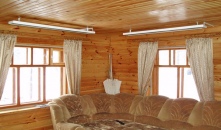IR heaters

IR heaters
Infrared radiation has long been known in the scientific world. It is not something harmful or artificially created, because absolutely all heated objects in any state of aggregation are endowed with the possibility of emitting IR waves. The range of electromagnetic waves, which includes infrared rays, is the most acceptable for humans, and is perceived by them as a simple sensation of heat.
Today, there are a large number of heaters, the operation of which is based on one of three types of infrared radiation. So, short-wave infrared heaters are popular for the possibility of spot or local heating. These are UFO and other variations that are installed directly next to the heating facility. Medium-wave and long-wave heaters have a wider focus and, accordingly, more opportunities for use. Their main difference from the first is that they do not glow during operation and are able to serve not only as local heating, but also as the main.
Why such differences, you ask? The thing is that the wavelength affects the intensity of heating and the proximity of the waves to the spectrum, visible to humans. Thus, the shortest infrared rays are in the range of electromagnetic waves from 0.74 microns to 1.5 microns and are the "hottest", and their glow can be seen with the naked eye. Medium (1.5-5.6 microns) and long (from 5.6 microns to 1000-2000 microns) are more convenient for continuous heating, since they do not illuminate the room and are able to gently warm the environment. Infrared heat is directly transmitted to all objects and even to a person directly, and not through heated air. Thus, we can talk about unprecedented energy savings and a significant reduction in heat loss. The presence of an infrared heater will help to create a quickly heated zone in any room, where a comfortable temperature will be reached in a few minutes, and heat from heated objects can be transferred to the air throughout the room. Their main difference from the first is that they do not glow during operation and are able to serve not only as additional heating, but also as the main.
Consider the main technical parameters by which you can select a specific type of heater IR:
Energy carrier: of course, the heater must draw energy during operation to convert it into heat. This source can be and most often is electricity. Infrared heaters owe such energy to their simplicity of installation and the absence of the need to obtain permits. Installed, plugged in - and you're done! There are also gas and liquid fuel units, which are most often designed for industrial premises at enterprises, factories, factories.
Surface temperature: somewhat arbitrary indicator, because each manufacturer focuses on the gradation of temperatures of their own products. According to the general capabilities of the heaters, it is possible to distinguish low-temperature (from 25 to 100 degrees), heaters with a temperature of 100 to 300 degrees fall into the middle range, and high-temperature - more than 300 ° С.
Design: as a rule, infrared heaters are similar in design and details included in the design. Most often, they are a connection of a heating element with a reflector and a radiator - these are the three main elements that are enclosed in a heat-resistant metal case along with electrical fittings. There are two exceptions - these are infrared films and glass panels, which have a different design and in some cases are better suited for heating an object..
Heating element: in Teplov’s IR heater, TENs are used, however, there are other elements that emit IR waves - these are halogen and quartz lamps, electric cables, coal-graphite powder mixture and others.
Method and place of installation: IR heaters can be installed on ceilings, walls, structures for lighting and even create the effect of a “warm floor” with them, laying infrared films under a tile or other floor covering. To heat the soil in greenhouses, such films can even be buried in the ground. Mounting methods are quite simple - it is direct mounting on the surface, hanging on ropes or removal on brackets (mainly suitable for ceiling IR heaters).
Safety: in order for IR heaters to serve you for a long time and in accordance with the guarantees provided, the rules for their operation must be observed. Such equipment should not be installed in rooms with high humidity and the possibility of direct contact with water on the housing, heating element and electrical wiring. It is also worth considering the parameters of the room, since it is not recommended to install infrared heaters on ceilings below 220-240 cm. For a person, IR heating is absolutely safe, because it only favorably affects the body, and also does not burn out the air and does not raise dust.
The advantages of infrared heaters have long been appreciated at many enterprises, firms, in retail and even in residential premises, both in our country and abroad. By heating production and storage facilities, enterprise managers obtained excellent results, because the efficiency indicators for infrared heating systems are 40-50% higher than for convective ones. It's all about the efficiency coefficient, which for infrared heaters is 0.8, and for convective systems - 1.2-1.3.
And the last touch to the description of infrared heating systems is an absolute harmony with the surrounding interior. We can paint a thin stylish heater case in any color according to your desire, and the absence of visible light radiation will not spoil the light composition in the room.
